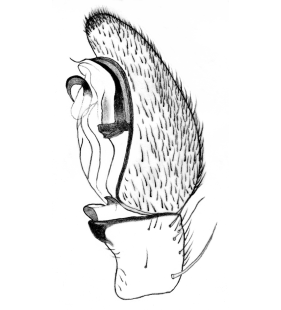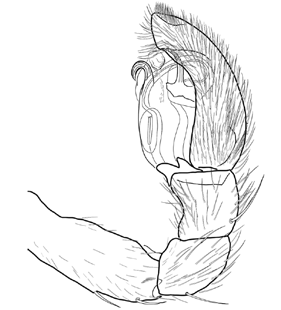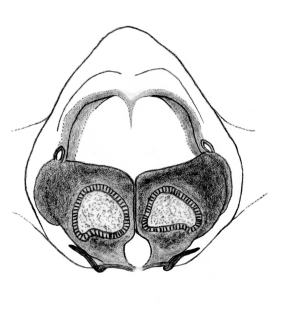Celerrimus duffeyi Lecigne, 2019
Beschreibung
Männchen
Opisthosoma mit variablem Muster, stärker bis wenig konstrastreich.
Beinbestachelung (basaler - mittlerer - apikaler Abschnitt): Femur dorsal 1 - 1 - 1 (manchmal apikal ein vierter, sehr kurzer Stachel), Tibia ventral 2 (0.15-0.17) - 2 (0.50-0.52) - 2 (0.93) (das dritte Paar kürzer), Metatarsus ventral 2 - 2 (0.54) - 0, Tarsus stachellos, der Rest ist variabel.
Pedipalpus: Tibia mit abgerundeter, dicker und breiter VTA, RTA sklerotisiert, pfeilspitzenförmig, nach außen weisend, anteriorer Abschnitt fast horizontal, apikaler Abschnitt abgerundet und nach außen gebogen. Cymbium oval, asymmetrisch mit einer seitlichen Achse in 1-Uhr-Position. Konduktor-Fortsatz in retrolateral-distaler Position, deutlich ausgebildet, lamellar und hakenförmig, leicht retrolateral gedreht. Der Konduktor bildet einen breiten membranösen Auswuchs. Basis des Embolus deutlich verbreitert, die Verbindung zum Embolus stark sklerotisiert. Embolus relativ kurz, in retrolaterale Richtung weisend, in 3-Uhr-Position beginnend, schnell verschlankend und in 0- bis 1-Uhr-Position endend.
Körperlänge Männchen: 4.60-5.27 mmWeibchen
Färbung und Beinbestachelung wie beim Männchen.
Epigyne/Vulva: Epigyne anterior zu einem Atrium geformt, breit (0.26-0.30 mm), ungeteilt, mit zwei Bögen. Das mediane Septum posterior mit stark slerotisierten Rändern, distal mehr oder weniger umgebogen, in den lateral-proximalen Abschnitten in der Epigynengrube mündend. Receptacula wuchtig, sich den gesamten inneren Rand entlang berührend, breiter als das Atrium. Sehr kleine Drüsenköpfe ohne Gänge, direkt am Hauptkörper der Receptacula ansetzend, in distal-lateraler Position, in inner-distale Richtung weisend.
Körperlänge Weibchen: 4.87-6.07 mmZusätzliche Informationen
Die Art wurde regelmäßig in Kiefernwälder und auf Lichtungen erfasst (besonders Pinus nigra) und auch in Buschland auf Pinus halepensis. Aber die Art kommt auch in anderen Lebensräumen wie steinigen Wiesen mit kurzem Bewuchs (10 cm), am Rand eines Weihers auf Büschen (auf Pistacia lentiscus) und auch in Gärten (mit Bäumen - z.B. Thuja, Pseudotsuga, Quercus) vor.
Von 20 bis 1210 m Meereshöhe.
Verbreitung
Phänologie
| Jan | Feb | Mar | Apr | May | Jun | Jul | Aug | Sep | Oct | Nov | Dec |
 |  |
Abbildungen
Verbreitungsnachweise
"No reference" bedeutet nicht, dass die Art in diesem Land nicht vorkommt, sondern dass wir die Referenz hierfür noch nicht eingefügt haben. Wir arbeiten daran.
Literatur
Breitling R (2020) South European spiders from the Duffey collection in the Manchester Museum (Arachnida: Araneae). Arachnology 18: 333-362 ![]()
Lecigne S, Cornic J-F, Oger P, Van Keer J (2019) Celerrimus n. gen. (Araneae, Philodromidae) et description de Celerrimus duffeyi n. sp., une espèce très singulière d’Europe occidentale. Revue Arachnologique (2) 6: 32-51 ![]()
WSC (2025) World Spider Catalog. Version 26. Natural History Museum Bern, online at http://wsc.nmbe.ch (28.2.2025) doi: 10.24436/2 ![]()












